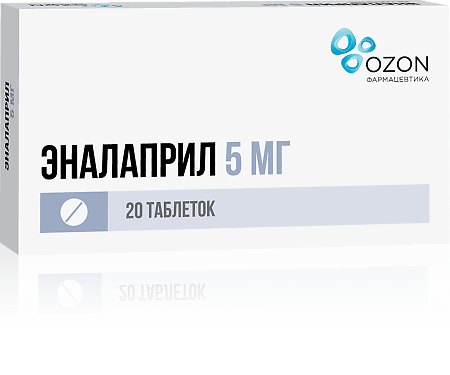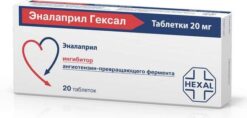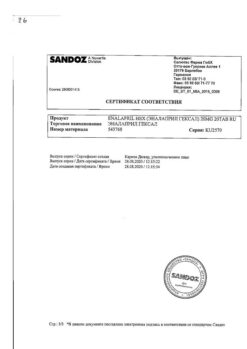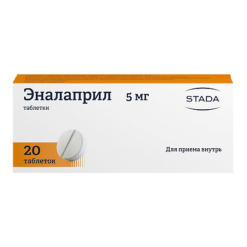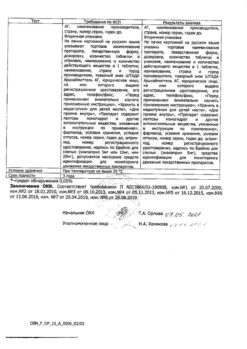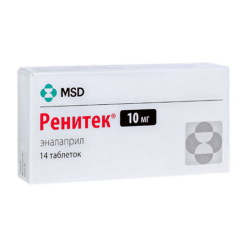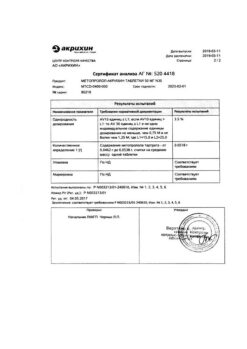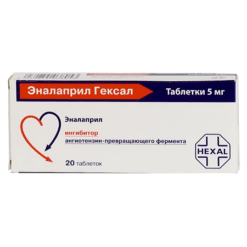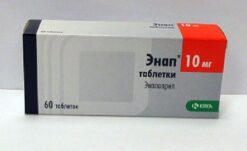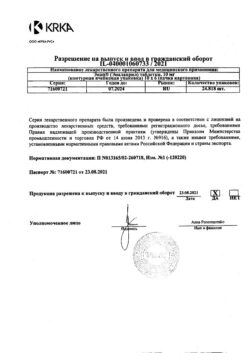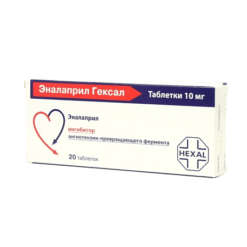No products in the cart.
Enalapril, tablets 5 mg, 20 pcs.
€1.00
Out of stock
(E-mail when Stock is available)
Description
Enalapril is an ACE inhibitor. It is a prodrug, from which the active metabolite enalaprilat is formed in the body.
Indications
Indications
• Essential hypertension of any severity;
• Renovascular hypertension;
• Heart failure of any severity.
In patients with manifestations of HF, Enalapril is also indicated for:
– increasing patient survival;
– slowing down the progression of heart failure;
– reducing the frequency of hospitalizations for HF.
• Prevention of the development of clinically significant heart failure.
In patients without clinical symptoms of heart failure with left ventricular dysfunction, Enalapril is indicated for:
– slowing down the development of clinical manifestations of heart failure;
– reducing the frequency of hospitalizations for HF.
• Prevention of coronary ischemia in patients with left ventricular dysfunction.
The drug is indicated for:
– reducing the incidence of myocardial infarction;
– reducing the frequency of hospitalizations for unstable angina.
Pharmacological effect
Pharmacological effect
Pharmacotherapeutic group: angiotensin-converting enzyme (ACE) inhibitor.
ATX code: C09AA02
Pharmacological properties
Pharmacodynamics
Enalapril is an antihypertensive drug whose mechanism of action is associated with inhibition of the activity of angiotensin-converting enzyme (ACE), leading to a decrease in the formation of angiotensin II. As a result of the hydrolysis of enalapril, enalaprilat is formed, which inhibits ACE.
It is used for the treatment of essential hypertension (primary arterial hypertension (AH) of any severity) and renovascular hypertension, both in monotherapy and in combination with other antihypertensive drugs, in particular with diuretics. Enalapril is also used to treat or prevent the development of heart failure (HF).
Enalapril is a derivative of two amino acids, L-alanine and L-proline. Enalapril is a prodrug: as a result of its hydrolysis, enalaprilat is formed, which is a highly specific and long-acting ACE inhibitor that does not contain a sulfhydryl group.
ACE (peptidyl dipeptidase A) catalyzes the conversion of angiotensin I to the pressor peptide angiotensin II. The mechanism of its action is associated with a decrease in the formation of angiotensin II from angiotensin I, which leads to an increase in plasma renin activity (due to the elimination of negative feedback in response to renin release) and a decrease in aldosterone secretion. At the same time, total peripheral vascular resistance, systolic and diastolic blood pressure (BP), post- and preload on the myocardium decrease. Enalapril dilates arteries more than veins, and there is no reflex increase in heart rate.
ACE is identical to the enzyme kininase II, so enalapril can also block the destruction of bradykinin, a peptide that has a pronounced vasodilating effect. The significance of this effect in the therapeutic action of enalapril requires clarification.
Enalapril increases the synthesis of prostaglandins. Despite the fact that the main mechanism of the antihypertensive effect of enalapril is considered to be the suppression of the activity of the renin-angiotensin-aldosterone system (RAAS), which plays an important role in the regulation of blood pressure, enalapril also exhibits an antihypertensive effect in patients with reduced plasma renin activity. The antihypertensive effect is more pronounced with high renin activity than with normal or reduced renin activity.
Reducing blood pressure within therapeutic limits does not affect cerebral circulation. Blood flow in the vessels of the brain is maintained at a sufficient level and against the background of reduced blood pressure. Strengthens coronary and renal blood flow.
With long-term use, enalapril reduces hypertrophy of the left ventricle of the myocardium and myocytes of the walls of resistive arteries, prevents the progression of chronic heart failure (CHF), slows down the development of left ventricular dilatation, and improves blood circulation in ischemic myocardium. Has some diuretic effect. Reduces intraglomerular hypertension, slowing the development of glomerulosclerosis and the risk of developing chronic renal failure.
With long-term use in patients with a reduced glomerular filtration rate, it reduces the symptoms of fluid and sodium retention in the body, and also has a positive effect on the ratio of lipoprotein fractions. In addition, the use of enalapril is characterized by the absence of an effect or a positive effect on the concentration of total cholesterol.
The antihypertensive effect develops within 1 hour, the maximum reduction in blood pressure is observed 4-6 hours after oral administration. The duration of action depends on the size of the dose taken. When using recommended doses of enalapril, the antihypertensive effect and hemodynamic effects persist for 24 hours.
In CHF, a noticeable clinical effect is observed with long-term therapy – 6 months or more. The duration of the therapeutic effect is dose-dependent.
Symptomatic postural hypotension occurs infrequently. In some patients, achieving optimal blood pressure reduction may require several weeks of therapy. Interruption of enalapril therapy does not cause a sharp rise in blood pressure.
Pharmacokinetics
Suction
After oral administration, enalapril is rapidly absorbed from the gastrointestinal tract. The extent of absorption of enalapril when taken orally is approximately 60%. Concomitant food intake does not affect the absorption of enalapril. Maximum serum concentrations are achieved within 1 hour after oral administration.
After absorption, enalapril is rapidly hydrolyzed to form the active metabolite enalaprilat, a powerful ACE inhibitor. Bioavailability when taken orally is about 40% in the form of enaprilat.
Distribution
In the range of therapeutic doses, the binding of enalaprilat to plasma proteins does not exceed 60%. Enalapril easily penetrates histohematic barriers, excluding the blood-brain barrier, a small amount penetrates the placenta and into breast milk. The maximum concentration of enalaprilat in the blood serum is observed after 3-4 hours, enalapril – after 1 hour. Stable serum concentrations – after 4 days.
Metabolism
There is no data on other significant pathways of metabolism of enalapril other than hydrolysis by liver enzymes to enalaprilat. Approximately 60% of absorbed enalapril is hydrolyzed. The rate of hydrolysis may be reduced in patients with impaired liver function without reducing the therapeutic effect.
The extent of absorption and hydrolysis of enalapril is the same for different doses within the recommended therapeutic range.
Removal
Enalaprilat is excreted primarily through the kidneys. The main metabolites detected in urine are enalaprilat, accounting for approximately 40% of the dose, and unchanged enalapril (approximately 20%). There are no data on other metabolites of enalapril.
The plasma concentration curve of enalaprilat has a long terminal phase, apparently due to its binding to ACE.
The half-life (T1/2) of enalaprilat during a course of oral administration of enalapril is 11 hours. It is removed by hemodialysis (rate 62 ml/min) and peritoneal dialysis.
Special patient groups
Patients with impaired renal function
Exposure to enalapril and enalaprilat is increased in patients with renal impairment.
In patients with mild to moderate renal failure (creatinine clearance (CC) 40-60 ml/min) after taking enalapril orally at a dose of 5 mg 1 time per day, the area under the concentration-time curve (AUC) at steady state was approximately 2 times higher than in patients with unchanged renal function. In patients with severe renal failure (creatinine clearance less than 30 ml/min), the AUC value increased approximately 8-fold. The effective T1/2 of enalaprilat increased after repeated use of enalapril in patients with severe renal failure, and the onset of steady-state enalaprilat concentrations was delayed.
Enalaprilat can be removed from the general circulation by hemodialysis.
Special instructions
Special instructions
Symptomatic hypotension
The issue of using double blockade of the RAAS (for example, by simultaneous use of an ACE inhibitor with ARA II) must be decided in each case individually with careful monitoring of renal function.
Caution must be exercised in patients with reduced blood volume (including concomitant use with diuretics, in conditions of limited salt intake, hemodialysis, vomiting, diarrhea), in whom a sudden and pronounced decrease in blood pressure may develop in response to the use of an ACE inhibitor. In patients with CHF I, II functional class according to the NYHA classification, chronic renal failure or without it, symptomatic arterial hypotension is usually not observed. The development of arterial hypotension is most likely in patients with more severe CHF due to the use of high doses of diuretics, hyponatremia or functional renal failure. In these patients, therapy should be started under medical supervision until the optimal dose adjustment of Enalapril and/or diuretic is achieved.
Similar tactics can be applied to patients with coronary artery disease or cerebrovascular diseases, in whom a pronounced decrease in blood pressure can lead to myocardial infarction or cerebrovascular accident.
If arterial hypotension develops, the patient should be laid down, legs elevated and, if necessary, a 0.9% sodium chloride solution should be administered. Transient arterial hypotension when taking the drug Enalapril is not a contraindication to its further use after stabilization of blood pressure and replenishment of blood volume.
In some patients with CHF with normal or low blood pressure, an additional decrease in blood pressure may occur when using the drug Enalapril. This is usually not a reason to discontinue the drug. If arterial hypotension develops, it is necessary to reduce the dose and/or discontinue the diuretic and/or Enalapril.
Aortic or mitral stenosis/HOCM
As with all drugs that have a vasodilating effect, ACE inhibitors should be used with caution in patients with left ventricular hypertrophy and valvular obstruction and should be avoided in cases of cardiogenic shock and hemodynamically significant obstruction.
Renal dysfunction
In case of impaired renal function (creatinine clearance less than 80 ml/min), careful monitoring of potassium and creatinine levels in the blood serum is necessary.
In patients with impaired renal function, it may be necessary to reduce the dose and/or frequency of dosing. In some patients with bilateral renal artery stenosis and stenosis of the artery of a solitary kidney, when treated with ACE inhibitors, an increase in the concentration of urea in the blood plasma and creatinine in the serum was observed, these changes were usually reversible, as a rule, the indicators returned to normal after cessation of therapy.
In some patients in whom renal disease was not detected before initiation of therapy, slight and transient increases in serum urea and creatinine concentrations were observed when enalapril was used concomitantly with diuretics. In such cases, it may be necessary to reduce the dose and/or discontinue enalapril and/or diuretic.
Patients with bilateral renal artery stenosis or arterial stenosis of a solitary kidney taking ACE inhibitors are at increased risk of developing hypotension and renal failure. Only moderate changes in plasma creatinine concentration can indicate a decrease in renal function. In such patients, treatment should begin with small doses under medical supervision, gradually selecting an individual dose and monitoring the concentration of creatinine in the blood serum.
Kidney transplant
There is no experience with the use of enalapril in patients after kidney transplantation. Treatment with enalapril in patients after kidney transplantation is not recommended.
Liver failure
The use of enalapril in patients with liver failure usually does not require dose adjustment. Rarely, when treated with ACE inhibitors, a syndrome is observed that begins with cholestatic jaundice or hepatitis, which progresses to fulminant liver necrosis, sometimes with death. The mechanism of this syndrome has not been studied. Patients who develop jaundice or a marked increase in the activity of liver transaminases during treatment with ACE inhibitors should discontinue the ACE inhibitors and prescribe appropriate auxiliary therapy. The patient must be under medical supervision.
Neutropenia/agranulocytosis
There are reports of the development of neutropenia/agranulocytosis, thrombocytopenia and anemia in patients receiving treatment with ACE inhibitors. The risk of neutropenia likely depends on the dose and the clinical condition of the patient. Neutropenia may occur more often in patients with reduced renal function, especially if there is a concomitant connective tissue disease (systemic lupus erythematosus, scleroderma) or when treated with immunosuppressants, allopurinol or procainamide, as well as a combination of these complicating risk factors. Some of these patients developed severe infectious diseases, which in some cases did not respond to intensive antibiotic therapy. When using enalapril in such patients, it is advisable to carry out monitoring of blood leukocytes and a complete blood count before treatment, every 2 weeks in the first three months of treatment, and then regularly. The patient should be strongly advised to report any symptom of an infectious disease (eg, sore throat, fever) to the doctor; in this case, the leukocyte blood count should be monitored. If neutropenia (less than 1000/mm3) is suspected or detected, which is reversible, Enalapril and other drugs taken at the same time should be discontinued (see section “Interaction with other drugs”).
Hypersensitivity reactions/angioedema
When using ACE inhibitors, including enalapril, in rare cases and during any period of therapy, the development of angioedema of the face, upper and lower extremities, lips, mucous membranes, tongue, vocal folds and/or larynx may be observed (see section “Side effects”). If symptoms appear, the drug should be stopped immediately and the patient should be observed until signs of edema completely disappear. If the swelling affects only the face and lips, it usually resolves on its own, although antihistamines may be used to treat symptoms.
Angioedema, accompanied by swelling of the larynx, can be fatal. Swelling of the tongue, vocal folds, or larynx can lead to airway obstruction, especially in patients with a history of respiratory surgery.
In case of airway obstruction, emergency treatment is required as soon as possible, including subcutaneous administration of 0.3-0.5 ml of epinephrine (adrenaline) solution in a ratio of 1:1000 and/or ensuring airway patency (intubation or tracheostomy).
In black patients taking ACE inhibitors, angioedema developed more often than in patients of other races.
Patients with a history of angioedema not associated with taking ACE inhibitors may be at greater risk of developing angioedema during therapy with ACE inhibitors (see section “Contraindications”).
In rare cases, intestinal edema develops during therapy with ACE inhibitors. In this case, patients experience abdominal pain as an isolated symptom or in combination with nausea and vomiting, in some cases without previous angioedema of the face and with normal levels of C1-esterase. The diagnosis was made using abdominal computed tomography, ultrasound, or surgery. Symptoms disappeared after stopping the ACE inhibitors. Therefore, in patients with abdominal pain receiving ACE inhibitors, when carrying out differential diagnosis, it is necessary to take into account the possibility of developing angioedema of the intestine (see section “Side effects”).
In patients taking ACE inhibitors and mammalian target of rapamycin (mTOR) inhibitors, estramustine, racecadotril, gliptins, an increased risk of developing angioedema was observed (see section “Interaction with other drugs”).
Anaphylactoid reactions during desensitization with an allergen from Hymenoptera venom
In rare cases, patients taking ACE inhibitors have developed life-threatening anaphylactoid reactions during desensitization with hymenoptera venom allergen. To avoid corresponding reactions, before each session of desensitizing therapy, therapy with ACE inhibitors should be temporarily discontinued. The use of ACE inhibitors should be avoided in patients receiving bee venom immunotherapy.
Anaphylactoid reactions during low-density lipoprotein apheresis (LDL apheresis)
In rare cases, life-threatening anaphylactoid reactions may occur in patients receiving ACE inhibitors during LDL apheresis using dextran sulfate. To prevent an anaphylactoid reaction, ACE inhibitor therapy should be temporarily discontinued before each LDL apheresis procedure.
Patients on hemodialysis
It should be borne in mind that when treated with Enalapril in patients who are indicated for hemodialysis, anaphylactoid reactions may develop (facial swelling, skin flushing, marked decrease in blood pressure, shortness of breath) due to the use of high-throughput filter membranes consisting of polyacrylonitrile (for example, high-flow membranes AN69®). It is recommended to use other types of dialysis membranes for hemodialysis or antihypertensive drugs of other pharmacotherapeutic groups.
Hypoglycemia
When using Enalapril in patients with diabetes mellitus receiving oral hypoglycemic agents or insulin, blood glucose concentrations should be regularly monitored during the first month of therapy.
Cough
Cough may occur during therapy with ACE inhibitors. As a rule, this is a dry cough that is permanent and disappears after stopping treatment. Cough associated with the use of ACE inhibitors should be considered in the differential diagnosis of cough.
Surgery/general anesthesia
During major surgery or general anesthesia with the use of drugs that cause an antihypertensive effect, enalaprilat blocks the formation of angiotensin II caused by the compensatory release of renin. If a pronounced decrease in blood pressure develops, explained by a similar mechanism, it can be corrected by increasing the volume of blood volume. It is necessary to warn the surgeon/anesthesiologist that the patient is taking ACE inhibitors.
Hyperkalemia (see section “Interaction with other drugs”)
During treatment with Enalapril, an increase in potassium levels in the blood serum is possible. Risk factors for hyperkalemia are renal failure, old age (over 65 years), diabetes mellitus, some concomitant conditions (decrease in volume, acute heart failure in the stage of decompensation, metabolic acidosis), simultaneous use of potassium-sparing diuretics (for example, spironolactone, eplerenone, amiloride, triamterene), potassium preparations or potassium-containing salt substitutes and the use of other drugs that increase serum potassium levels (for example, heparin). The use of potassium supplements, potassium-sparing diuretics or potassium-containing table salt substitutes, especially in patients with renal failure, can lead to a significant increase in plasma potassium levels. Hyperkalemia can cause serious heart rhythm disturbances, sometimes fatal. The simultaneous use of Enalapril with any of the drugs listed above must be carried out with extreme caution, and it should be accompanied by regular monitoring of potassium levels in the blood plasma.
Lithium preparations
The simultaneous use of lithium and enalapril is not recommended (see section “Interaction with other drugs”).
Double blockade of the RAAS
Cases of hypotension, syncope, stroke, hyperkalemia and renal dysfunction (including acute renal failure) have been reported in susceptible patients, especially when used concomitantly with drugs that affect this system. Therefore, double blockade of the RAAS by combining an ACE inhibitor with an ARA II or aliskiren is not recommended.
The simultaneous use of Enalapril with aliskiren and aliskiren-containing drugs is contraindicated in patients with diabetes mellitus and/or moderate or severe renal failure (GFR less than 60 ml/min/1.73 m2 body surface area) (see sections “Contraindications” and “Interaction with other drugs”) and is not recommended in other patients. The simultaneous use of ACE inhibitors and ARB II is contraindicated in patients with diabetic nephropathy and is not recommended in other patients.
Use in elderly patients
The results of clinical studies of the efficacy and safety of enalapril were similar in older and younger patients with hypertension.
Race
The drug Enalapril, like other ACE inhibitors, has a less pronounced antihypertensive effect in patients of the Black race compared to representatives of other races, possibly due to low renin activity in patients with arterial hypertension in this population.
Sudden cessation of taking Enalapril does not lead to the development of withdrawal syndrome.
Impact on the ability to drive vehicles and machinery
When using Enalapril drugs, caution should be exercised when driving vehicles and engaging in potentially hazardous activities that require increased concentration and speed of psychomotor reactions (risk of dizziness, drowsiness).
Active ingredient
Active ingredient
Enalapril
Composition
Composition
1 tablet 5 mg contains:
Active ingredient: enalapril maleate – 5.0 mg.
Excipients: lactose monohydrate – 74.1 mg, potato starch – 17.0 mg, sodium bicarbonate – 2.6 mg, calcium stearate – 1.3 mg.
1 tablet 10 mg contains:
Active ingredient: enalapril maleate – 10.0 mg.
Excipients: lactose monohydrate – 66.6 mg, potato starch – 17.0 mg, sodium bicarbonate – 5.1 mg, calcium stearate – 1.3 mg.
1 tablet 20 mg contains:
Active ingredient: enalapril maleate – 20.0 mg.
Excipients: lactose monohydrate – 133.2 mg, potato starch – 34.0 mg, sodium bicarbonate – 10.2 mg, calcium stearate – 2.6 mg.
Pregnancy
Pregnancy
Pregnancy
The use of Enalapril during pregnancy is not recommended.
If pregnancy is confirmed during therapy with Enalapril, the drug should be stopped immediately.
A published retrospective epidemiologic study of infants whose mothers took ACE inhibitors during the first trimester of pregnancy reported an increased risk of major congenital malformations compared with infants whose mothers did not take ACE inhibitors during the first trimester of pregnancy. The incidence of birth defects was low and the results of this study have not been reconfirmed.
ACE inhibitors can cause disease or death of the fetus or newborn when used by pregnant women during the second and third trimesters of pregnancy.
The use of ACE inhibitors in the second and third trimesters of pregnancy was accompanied by negative effects on the fetus and newborn, which manifested itself in the form of arterial hypotension, renal failure, hyperkalemia and/or hypoplasia of the skull bones in the newborn. Prematurity, intrauterine growth restriction, and patent ductus arteriosus have also been reported, but it is unclear whether these cases were related to the effects of ACE inhibitors.
Oligohydramnios may develop due to impaired fetal renal function. This complication can lead to contracture of the limbs, deformation of the bones of the skull, including its facial part, and hypoplasia of the fetal lungs.
These undesirable effects on the embryo and fetus do not appear to be the result of intrauterine exposure to ACE inhibitors during the first trimester of pregnancy.
When using Enalapril during pregnancy, the patient must be informed of the potential risk to the fetus.
In those rare cases when the use of the drug during pregnancy is vital for the mother, periodic ultrasound examinations should be performed to assess the amniotic fluid index. If oligohydramnios is detected during an ultrasound examination, the drug should be stopped, except in cases where its use is vital for the mother.
The physician should remember and also inform the patient that oligohydramnios develops when there is irreversible damage to the fetus.
If ACE inhibitors are used during pregnancy and the development of oligohydramnios is observed, then, depending on the week of pregnancy, a stress test, a non-stress test or a fetal biophysical profile may be necessary to assess the functional status of the fetus. Newborns whose mothers took Enalapril during pregnancy should be carefully monitored for hypotension, oliguria and hyperkalemia. Enalapril penetrates the placental barrier. It can be partially removed from the newborn’s circulation using peritoneal dialysis. Theoretically, it can also be removed by exchange transfusion.
Breastfeeding period
Enalapril and enalaprilat are excreted into breast milk in trace amounts. If it is necessary to use the drug Enalapril during lactation, breastfeeding should be discontinued.
Contraindications
Contraindications
• Hypersensitivity to enalapril, other components of the drug or other ACE inhibitors;
• lactose intolerance, lactase deficiency or glucose-galactose malabsorption syndrome;
• history of angioedema associated with taking ACE inhibitors, as well as hereditary or idiopathic angioedema;
• pregnancy;
• breastfeeding period;
• age under 18 years (the effectiveness and safety of the drug have not been established);
• simultaneous use with aliskiren and aliskiren-containing drugs in patients with diabetes mellitus and/or moderate or severe renal impairment (glomerular filtration rate (GFR) less than 60 ml/min/1.73 m² body surface area) (see section “Interaction with other drugs”);
• simultaneous use with angiotensin II receptor antagonists (ARA II) in patients with diabetic nephropathy;
• simultaneous use with neutral endopeptidase inhibitors (for example, with drugs containing sacubitril) due to the high risk of developing angioedema.
With caution
• renovascular hypertension, bilateral renal artery stenosis, stenosis of the artery of a single kidney (risk of developing renal failure);
• coronary heart disease (CHD) and cerebrovascular diseases (including cerebrovascular insufficiency), because an excessive decrease in blood pressure can lead to the development of myocardial infarction and stroke;
• aortic and/or mitral stenosis (with impaired hemodynamic parameters), hypertrophic obstructive cardiomyopathy (HOCM);
• systemic connective tissue diseases (including systemic lupus erythematosus, scleroderma);
• inhibition of bone marrow hematopoiesis;
• immunosuppressive therapy, simultaneous use of allopurinol and procainamide or a combination of these complicating factors;
• hyperkalemia; simultaneous use with potassium-sparing diuretics (for example, spironolactone, eplerenone, amiloride, triamterene), potassium preparations, potassium-containing table salt substitutes; simultaneous use with lithium preparations;
• diabetes mellitus;
• primary hyperaldosteronism;
• condition after kidney transplantation (no experience of use);
• liver dysfunction;
• renal dysfunction (creatinine clearance less than 80 ml/min);
• conditions accompanied by a decrease in circulating blood volume (CBV) (as a result of diuretic therapy, with limited salt intake, diarrhea, vomiting, dialysis);
• use in elderly patients;
• during desensitization with an allergen from the venom of Hymenoptera;
• in patients after extensive surgery or during general anesthesia;
• in patients undergoing dialysis using high-flow membranes (such as AN 69®);
• carrying out the procedure of low-density lipoprotein apheresis (LDL apheresis) using dextran sulfate;
• use in patients of the Negroid race;
• a history of aggravated allergies or angioedema.
Side Effects
Side Effects
The incidence of adverse events is classified according to the recommendations of the World Health Organization: very common (>1/10), common (>1/100 and 1/1000 and 1/10000 and <1/1000), very rare (<1/10000), including isolated reports, frequency unknown (cannot be estimated based on available data)
Disorders of the blood and lymphatic system: infrequently – anemia (including aplastic and hemolytic); rarely – neutropenia, decreased hemoglobin and hematocrit, thrombocytopenia, agranulocytosis, suppression of bone marrow hematopoiesis, pancytopenia, lymphadenopathy, autoimmune diseases.
Endocrine system disorders: frequency unknown – syndrome of inappropriate secretion of antidiuretic hormone.
Metabolic and nutritional disorders: uncommon – hypoglycemia (see section “Special Instructions”).
Nervous system and mental disorders: very often – dizziness; often – headache, depression; uncommon – confusion, insomnia, increased excitability, paresthesia, vertigo; rarely – unusual dreams, sleep disturbances.
Violations of the organ of vision: rarely – blurred visual perception.
Hearing and labyrinthine disorders: uncommon – tinnitus.
Disorders of the heart and blood vessels: often – marked decrease in blood pressure, fainting, chest pain, arrhythmia, angina pectoris, tachycardia; uncommon – palpitations, orthostatic hypotension, myocardial infarction or cerebrovascular accident, possibly secondary to severe arterial hypotension in patients at high risk (see section “Special Instructions”); rarely – Raynaud’s syndrome.
Disorders of the respiratory system, chest and mediastinal organs: very often – cough; often – shortness of breath; uncommon – rhinorrhea, sore throat, hoarseness, bronchospasm/bronchial asthma; rarely – pulmonary infiltrates, rhinitis, allergic alveolitis/eosinophilic pneumonia.
Disorders of the digestive system: very often – nausea; often – diarrhea, abdominal pain, taste disturbance; uncommon – intestinal obstruction, pancreatitis, vomiting, dyspepsia, constipation, anorexia, dry oral mucosa, peptic ulcer; rarely – stomatitis/aphthous ulcers, glossitis; very rarely – intestinal edema.
Disorders of the liver and biliary tract: rarely – liver failure, liver necrosis (possibly fatal), hepatitis (hepatocellular or cholestatic), jaundice, cholecystitis (especially in patients with a history of cholelithiasis).
Disorders of the skin and subcutaneous tissues: often – skin rash, hypersensitivity reactions/angioedema: angioedema of the face, extremities, lips, tongue, vocal folds and/or larynx (see section “Special instructions”); uncommon – increased sweating, itching, urticaria, alopecia; rarely – exudative erythema multiforme, Stevens-Johnson syndrome, exfoliative dermatitis, toxic epidermal necrolysis, pemphigus, erythroderma.
A symptom complex has been reported that may include all or some of the following symptoms: fever, serositis, vasculitis, myalgia/myositis, arthralgia/arthritis, positive antinuclear antibody test, increased erythrocyte sedimentation rate (ESR), eosinophilia and leukocytosis. Skin rash, photosensitivity and other skin reactions may also occur.
Renal and urinary tract disorders: uncommon – renal dysfunction, acute renal failure, proteinuria; rarely – oliguria.
Disorders of the genital organs and mammary gland: infrequently – erectile dysfunction; rarely – gynecomastia.
General disorders and disorders at the injection site: very often – asthenia; often – increased fatigue; uncommon – fever, malaise, discomfort, flushing of the face, muscle cramps.
Laboratory and instrumental data: often – hyperglycemia, increased creatinine concentration in the blood serum; uncommon – hyponatremia, hyperuricemia; rarely – increased activity of “liver” transaminases, increased concentration of bilirubin in the blood serum.
When using ACE inhibitors, including enalapril, in patients receiving intravenous gold (sodium aurothiomalate), a symptom complex was described, including facial flushing, nausea, vomiting, and arterial hypotension.
Adverse events observed during post-marketing use of enalapril (causality not established): urinary tract infections, upper respiratory tract infections, bronchitis, cardiac arrest, atrial fibrillation, herpes zoster, melena, ataxia, pulmonary embolism and pulmonary infarction, hemolytic anemia, including cases of hemolysis in patients with deficiency glucose-6-phosphate dehydrogenase.
Interaction
Interaction
Potassium-sparing diuretics and potassium supplements
The simultaneous use of enalapril and potassium-sparing diuretics (spironolactone, eplerenone, triamterene, amiloride), potassium-containing salts, potassium supplements, as well as the use of other drugs that increase the content of potassium in the blood serum (for example, heparin) can lead to a significant increase in the content of potassium in the blood plasma. If, due to diagnosed hypokalemia, the simultaneous use of these drugs is still indicated, they should be used with caution, with regular monitoring of potassium levels in the blood serum (see section “Special Instructions”).
Diuretics (thiazide and loop)
The use of diuretics in high doses can lead to hypovolemia (due to a decrease in circulating blood volume (CBV)), and the addition of enalapril can lead to a pronounced decrease in blood pressure. Excessive antihypertensive effect of enalapril can be reduced either by discontinuing the diuretic, or by increasing the volume of blood volume or consuming table salt, as well as by reducing the dose of enalapril.
Other antihypertensive drugs
An additive effect may be observed with concomitant use of enalapril and other antihypertensive therapy.
The simultaneous use of enalapril with beta-blockers, methyldopa or blockers of “slow” calcium channels increases the severity of the antihypertensive effect.
The simultaneous use of enalapril with alpha-, beta-blockers and ganglion blockers should be carried out under strict medical supervision.
Concomitant use with nitroglycerin in various dosage forms and other nitrates or other vasodilators enhances the antihypertensive effect.
Lithium preparations
ACE inhibitors, including enalapril, reduce the excretion of lithium by the kidneys and increase the risk of lithium intoxication (increased cardiotoxic and neurotoxic effects of lithium). If it is necessary to use this combination, the concentration of lithium in the blood plasma should be regularly monitored.
Tricyclic antidepressants/neuroleptics/general anesthetics
The simultaneous use of certain general anesthesia agents, tricyclic antidepressants and antipsychotics with ACE inhibitors can lead to an enhanced antihypertensive effect and increase the risk of developing orthostatic hypotension (additive effect).
Nonsteroidal anti-inflammatory drugs (NSAIDs)
NSAIDs, including selective cyclooxygenase-2 (COX-2) inhibitors, may reduce the antihypertensive effect of antihypertensive drugs. As a result, the antihypertensive effect of angiotensin II receptor antagonists (ARA II) or ACE inhibitors may be weakened when used simultaneously with NSAIDs, including selective COX-2 inhibitors.
NSAIDs and ACE inhibitors have an additive effect on increasing serum potassium, which may lead to a deterioration of renal function, especially in patients with impaired renal function (for example, elderly patients or patients with dehydration, including those taking diuretics) receiving therapy with NSAIDs, including selective COX-2 inhibitors; concomitant use of ARB II or ACE inhibitors may cause a further deterioration of renal function, including development of acute renal failure. These effects are usually reversible, so concomitant use of these drugs should be done with caution in patients with impaired renal function.
Gold preparations
A complex of symptoms (nitrate-like reactions), including a feeling of “flushing” of blood to the facial skin, nausea, vomiting and arterial hypotension, was observed with the simultaneous use of gold preparations for parenteral administration (sodium aurothiomalate) and ACE inhibitors, including enalapril.
Sympathomimetics
Sympathomimetics may reduce the antihypertensive effect of ACE inhibitors. To confirm the antihypertensive effect, such patients should be under close medical supervision.
Hypoglycemic agents
Epidemiological studies have shown that the simultaneous use of ACE inhibitors and hypoglycemic agents (insulin, oral hypoglycemic agents) may enhance the hypoglycemic effect of the latter with the risk of developing hypoglycemia. This phenomenon, as a rule, was most often observed during the first weeks of combination therapy, as well as in patients with impaired renal function. In patients with diabetes mellitus taking oral hypoglycemic agents or insulin, blood glucose concentrations should be regularly monitored, especially during the first month of concomitant use with ACE inhibitors.
Ethanol
Ethanol enhances the antihypertensive effect of ACE inhibitors.
Acetylsalicylic acid, thrombolytics and beta-blockers
Enalapril can be used with acetylsalicylic acid (as an antiplatelet agent), thrombolytics and beta-blockers.
Allopurinol, cytostatics and immunosuppressants
Concomitant use with ACE inhibitors may increase the risk of developing leukopenia.
Cyclosporine
Concomitant use with ACE inhibitors may increase the risk of developing hyperkalemia.
Antacids
May reduce the bioavailability of ACE inhibitors.
Theophylline
Enalapril weakens the effect of medications containing theophylline.
No clinically significant pharmacokinetic interactions were observed with hydrochlorothiazide, furosemide, digoxin, timolol, methyldopa, warfarin, indomethacin, sulindac and cimetidine.
Double blockade of the RAAS
Dual blockade of the RAAS using ARB II and ACE inhibitors or aliskiren (renin inhibitor) is associated with an increased risk of arterial hypotension, syncope, hyperkalemia and renal dysfunction (including the development of acute renal failure) compared with the use of monotherapy. Regular monitoring of blood pressure, renal function and electrolyte levels in the blood plasma is necessary in patients taking simultaneously the drug Enalapril and other drugs that affect the RAAS.
Interaction with other drugs
Enalapril should not be used concomitantly with aliskiren and aliskiren-containing drugs in patients with diabetes mellitus and/or with moderate or severe renal impairment (GFR less than 60 ml/min/1.73 m² body surface area) (see section “Contraindications”) and is not recommended in other patients.
Concomitant use of enalapril with ARA II is contraindicated in patients with diabetic nephropathy (see section “Contraindications”) and is not recommended in other patients.
Dipeptidyl peptidase type IV (DPP-IV) inhibitors (gliptins) (linagliptin, saxagliptin, sitagliptin, vildagliptin)
Concomitant use with ACE inhibitors may increase the risk of developing angioedema due to inhibition of dipeptidyl peptidase type IV (DPP-IV) activity by gliptin.
Inhibitors of mTOR (mammalian Target of Rapamycin – the target of rapamycin in mammalian cells), for example, temsirolimus, sirolimus, everolimus, estramustine, when used in conjunction with enalapril, increase the risk of developing angioedema.
Neutral endopeptidase inhibitors
An increased risk of angioedema has been reported with concomitant use of ACE inhibitors and racecadotril (an enkephalinase inhibitor).
When ACE inhibitors are used simultaneously with drugs containing sacubitril (neprilysin inhibitor), the risk of developing angioedema increases, and therefore the simultaneous use of these drugs is contraindicated. ACE inhibitors should be prescribed no earlier than 36 hours after discontinuation of drugs containing sacubitril. Prescription of drugs containing sacubitril is contraindicated in patients receiving ACE inhibitors, as well as within 36 hours after discontinuation of ACE inhibitors.
Tissue plasminogen activators
Observational studies have shown an increased incidence of angioedema in patients taking ACE inhibitors following the use of alteplase for thrombolytic therapy of ischemic stroke.
Overdose
Overdose
Symptoms: pronounced decrease in blood pressure, up to the development of collapse, myocardial infarction, acute cerebrovascular accident or thromboembolic complications, water and electrolyte imbalance, renal failure, increased breathing, tachycardia, palpitations, bradycardia, dizziness, anxiety, fear, convulsions, cough, stupor.
Enalaprilat serum concentrations 100 and 200 times higher than those observed at therapeutic doses occurred following administration of 300 and 440 mg of enalapril, respectively.
Treatment: the patient is transferred to a horizontal position with a low headboard. In mild cases, gastric lavage and ingestion of saline solution are indicated; in more severe cases, measures aimed at stabilizing blood pressure are indicated: intravenous administration of 0.9% sodium chloride solution, plasma substitutes; if necessary, intravenous administration of catecholamines, hemodialysis (enalaprilat excretion rate is 62 ml/min). In patients with bradycardia that is resistant to therapy, placement of an artificial pacemaker is indicated.
Storage conditions
Storage conditions
At a temperature not exceeding 25 °C in a cardboard package (pack).
Keep out of the reach of children.
Shelf life
Shelf life
3 years.
Do not use after expiration date.
Manufacturer
Manufacturer
Ozon Pharm, Russia
Additional information
| Shelf life | 3 years |
|---|---|
| Conditions of storage | In a dry, light-protected place at a temperature not exceeding 25 °C |
| Manufacturer | Ozon, Russia |
| Medication form | pills |
| Brand | Ozon |
Other forms…
Related products
Buy Enalapril, tablets 5 mg, 20 pcs. with delivery to USA, UK, Europe and over 120 other countries.

